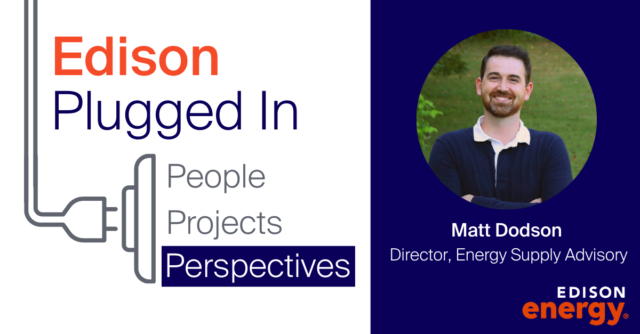
July 21, 2022
Integration of performance validation for renewable energy projects enables clients to “stay ahead of the curve”
By Elana Knopp, Senior Content Writer

In this last of a two-part series, Matt Dodson, Director of Energy Supply Advisory at Edison Energy, discusses the integration of performance validation to help track critical metrics like production, cash flow, and energy usage for clients across large renewable projects, as well as onsite solar, storage, and fuel cell installations. Click here to read the first part of the series.
Part II
Performance validation
Edison’s Energy Supply Advisory includes several commercial advisory teams focused on onsite solar and storage, also offering performance validation services to help large portfolio clients track offsite VPPA and PPA performance, as well as onsite solar performance.
“My focus here at Edison is to strategically grow these offerings, which means building out our teams and creating efficiencies, but also integrating performance validation as it pertains to large portfolios of onsite assets, not just large wind and solar VPPAs,” Dodson said.
This allows Edison to track metrics like production, cash flow, and energy usage for clients across large renewable projects, as well as hundreds of onsite solar, storage, and fuel cell installations that they may not be monitoring appropriately when it comes to maintenance schedules and expected savings.
This is achieved via Edison’s Insights platform, which also tracks 1,000+ renewable energy projects and 150+ developers and retailers; provides buyers with detailed insight into North American EU markets; and displays available utility-scale PPA opportunities, bid details, and economic analysis of forecasted PPA performance.
“We have really critical information housed in the Edison Insights platform, and our Performance Validation offering is a key component,” Dodson said. “This automated tool allows us to consistently track our clients’ offsite wind and solar projects and how they’re performing from a production and cash flow perspective. It’s a wonderful feeling to know we’re able to stay on top of whether clients are meeting the guarantees in their contracts, the financial return expectations they’ve set internally, or that they’re on track to meet their public-facing renewable energy goals.”
Edison also tracks new and evolving policies around onsite renewable generation across various states and utilities to help clients quickly monetize incentives to deploy onsite assets.
“It’s just being nimble, prepared, and educated so that we can bring information to clients and quickly transact in active markets,” Dodson said. “The other key reality is that we’ve clearly shifted from a buyer’s market to a seller’s market as it pertains to offsite wind and solar. What has been incredibly valuable for our clients is looking at onsite solar as a way to deploy cash flow-positive projects specifically to sites, irrespective of headwinds and uncertainty facing the offsite wind and solar markets.”
This mitigates risk to clients from increasing energy prices, as well as highlighting the long-term cash flow potential through the optimal utilization of incentives.
“Then a client can actually share internally that this strategy is able to offset potential increased costs that could be occurring with offsite wind and solar,” Dodson said. “We’ve had many recent examples of success with our clients because we help highlight the ability to focus on onsite solar as a way to potentially mitigate the cost increases with offsite renewables by focusing on states with solar friendly policy, incentives, or generally high energy prices. When you look at everything together in a holistic manner, it allows us to paint this longer-term strategic approach to emissions reductions and not just focus on one technology versus another.”
Edison is currently building out the platform’s near real-time settlements component, which enables clients to check in on pricing and performance on both a monthly and daily basis.
“For example, clients can check in on a nearly real-time basis to see how their wind or solar asset is performing during a really high price moment in ERCOT such as a summer hour or multi-hour event and know very quickly the outcomes of that type of moment,” Dodson said. “It’s great transparency and has been really well received by our clients. The ability for them to more actively track their renewable assets on a greater frequency than monthly is a unique advantage of Edison. It is one that we are proud to offer.”
The platform has been invaluable in informing client decision making around strategizing and purchasing. As an example, the tool can inform clients whether they will have surplus RECs due to asset performance, presenting an opportunity for clients to either monetize the RECs they don’t need, or to strategize future purchasing of RECs to ensure that they meet their targets.
“Being informed by the platform allows our clients to stay ahead of the curve as it pertains to their goals, and that’s really critical and a strategic advantage in these complex markets,” Dodson said.
Edison’s overarching strategy will continue to leverage an integrated approach to helping clients meet and exceed their energy and sustainability goals.
“Throughout my career, I’ve seen a clear bifurcation between conventional gas and power procurement and renewable energy, so it’s incredibly exciting that we are spending so much time here thinking and planning for a more integrated future between these two previously separated verticals,” Dodson said. “We are thinking critically about how energy efficiency plays into clean energy procurement, and how leading with sustainability can potentially lead to a number of different endeavors with energy efficiency, traditional gas and power, onsite solar, and even transportation electrification. It’s thinking about the interplay between all of these different functions impacting our clients that really has me excited me for the future.”
Get in touch with our team and schedule a demo of the Insights Platform.




